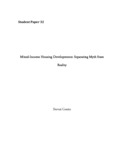| dc.contributor.author | Coutts, Steven | |
| dc.date.accessioned | 2016-03-14T14:53:36Z | |
| dc.date.available | 2016-03-14T14:53:36Z | |
| dc.date.issued | 2016-02-01 | |
| dc.identifier.isbn | 978-1-894858-41-0 | |
| dc.identifier.uri | http://hdl.handle.net/10680/1105 | |
| dc.description | Paper: 14pp., digital file. | en_US |
| dc.description.abstract | Mixed-income housing has long been promoted as a panacea to the largely-failed social
housing experiments of the mid-twentieth century. However, more often than not, the social mix philosophy leads to more problems than it solves. It amounts to a spatial solution to what are complex social and spatial problems. Moreover, the support for this approach calls into question its true motives: is it intended to truly benefit low-income populations or is it merely a form of stealth gentrification? A better solution would be to identify assets within existing low-income housing developments and increase investments in a targeted fashion, rather than expecting benefits to trickle down. | en_US |
| dc.language.iso | en | en_US |
| dc.publisher | Institute of Urban Studies | en_US |
| dc.relation.ispartofseries | Student Paper Series;32 | |
| dc.rights | info:eu-repo/semantics/openAccess | |
| dc.subject | Mixed-income housing -- canada | |
| dc.subject | Housing policy -- canada | |
| dc.subject | Housing policy -- manitoba -- winnipeg | |
| dc.title | Mixed-Income Housing Developments: Separating Myth from Reality | en_US |
| dc.type | Article | en_US |

